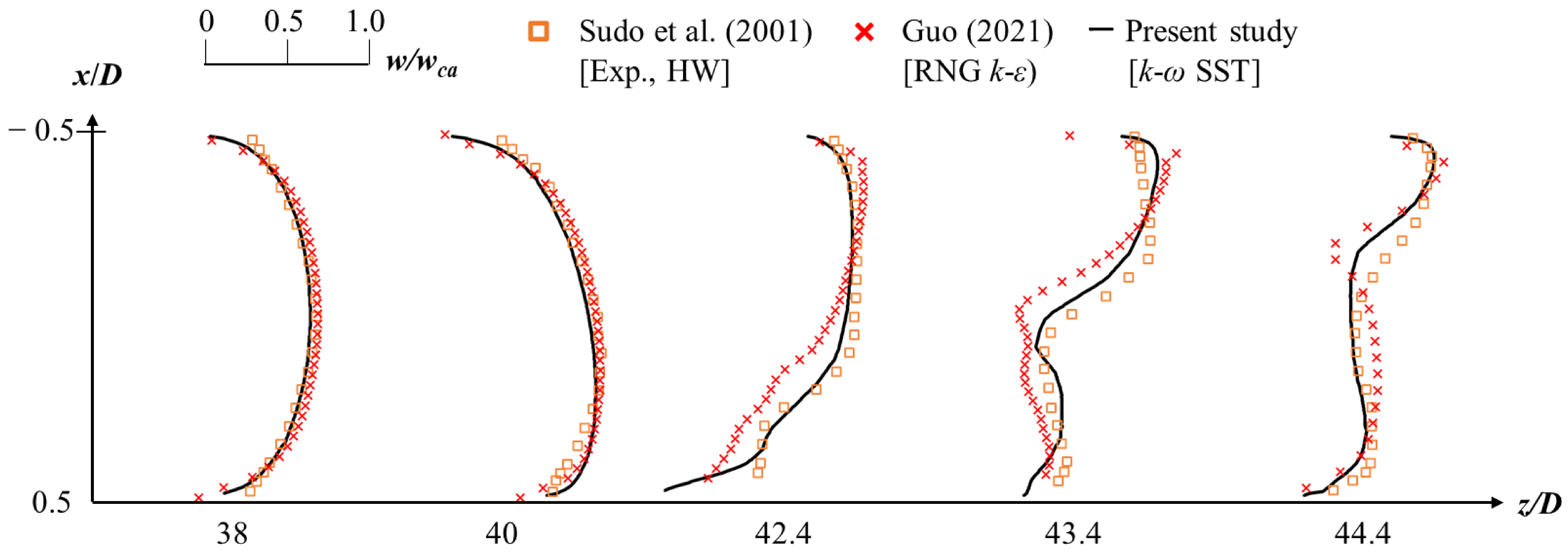Heat Transfer Characteristics of Turbulent Flow in Double-90°-Bend Pipes
Abstract
1. Introduction
- To experimentally clarify the effect of bending on the heat transfer characteristics of high-speed turbulent flow in a double-bend pipe, which is often observed in engine exhaust systems where previous studies are insufficient.
- To elucidate the heat transfer mechanism at the bend through numerical simulation.
2. Methods
2.1. Experimental Apparatus
2.2. Data Reduction
2.3. Flow Field Measurement
2.4. Numerical Simulations
3. Results and Discussion
3.1. Circumferential Temperature Fields in Cross-Sections and the Axial Temperature Distribution
3.2. CHT Simulation
3.2.1. Validation and Grid-Independence Study
3.2.2. Evaluation of Heat Transfer Characteristics
4. Conclusions
- Measurement of the cross-sectional temperature distribution of the internal fluid revealed that the high-temperature core is always at the center from upstream to downstream in the straight pipe, whereas in the double-bend pipe, the high-temperature core shifts outward at both the first and second bends. This shift appears to be due to the compressive effect of the centrifugal force.
- Evaluation of the characteristics of heat transfer from the internal fluid to the pipe wall showed that the double-bend pipe has 1.4 times the heat dissipation and twice the Nusselt number compared with a straight pipe.
- The evaluation of heat transfer characteristics in CHT simulation revealed that the first bend enhances heat dissipation to the pipe wall but the second bend does not. The large amount of heat dissipated to the pipe wall at the first bend is transferred upstream and downstream through the inside of the pipe by thermal conduction. The tendency for heat transfer enhancement to occur at the first bend is consistent with previous results by Guo [23] and Liberto et al. [29].
- The reason for enhanced heat dissipation at the first bend is enhanced eddy diffusion and increased turbulent heat flux due to the deflected flow. It is suggested that the enhanced eddy diffusion is caused by Dean vortices at the first bend.
- The reason for the lack of heat dissipation enhancement at the second bend is that eddy diffusion is not enhanced on the outside of the bend and the turbulent heat flux does not increase. It is suggested that this is a result of Lyne vortices, which are smaller than Dean vortices, forming on the outside of the second bend, resulting in less enhancement of eddy diffusion.
Author Contributions
Funding
Data Availability Statement
Conflicts of Interest
Nomenclature
| A | surface area [m2] | Greek symbols | |
| Cp | constant pressure specific [J/kg K] | λ | heat conductivity [W/m K] |
| D | pipe inner diameter [mm] | ρ | density [kg/m3] |
| Do | pipe outer diameter [mm] | μ | viscosity [Pa s] |
| De | Dean number | μt | eddy viscosity coefficient [Pa s] |
| f | friction coefficient | ν | dynamic viscosity [m2/s] |
| fs | frame speed [fps] | νt | eddy diffusivity [m2/s] |
| h | heat transfer coefficient [W/m2/K] | ω | turbulence eddy frequency [1/s] |
| k | turbulent kinetic energy [m2/s2] | τ | wall shear stress [Pa] |
| mass flow rate [kg/s] | |||
| Nu | Nusselt number | Subscripts | |
| Pr | Prandtl number | a | ambient |
| Prt | turbulent Prandtl number | al | aluminum |
| q | heat flux [W/m2] | b | bulk |
| Q | heat flow rate [W] | c | center |
| r | resolution [mm/pixel] | cr | cross sectional |
| Rc | radius of curvature [mm] | f | fluid |
| Re | Reynolds number | mfa | mass flow rate averaged |
| T | Temperature [K] | o | outer |
| u | velocity in horizontal coordinate [m/s] | PIV | particle image velocimetry |
| u+ | dimensionless velocity | w | wall |
| v | velocity in vertical coordinate [m/s] | wi | inner wall |
| w | velocity in streamwise coordinate [m/s] | wo | outer wall |
| x | horizontal coordinate | ||
| y | vertical coordinate | Superscripts | |
| y+ | dimensionless distance from wall () | ¯ | time averaged value |
| z | streamwise coordinate | ‘ | turbulent term |
References
- Host, R.; Moilanen, P.; Fried, M.; Bogi, B. Exhaust System Thermal Management: A Process to Optimize Exhaust Enthalpy for Cold Start Emissions Reduction; SAE Technical Paper; SAE International: Warrendale, PA, USA, 2017. [Google Scholar]
- Naphon, P.; Wongwises, S. A review of flow and heat transfer characteristics in curved tubes. Renew. Sustain. Energy Rev. 2006, 10, 463–490. [Google Scholar] [CrossRef]
- Dean, W.R.; Hurst, J.M. Note on the motion of fluid in a curved pipe. Mathematika 1959, 6, 77–85. [Google Scholar] [CrossRef]
- Brücker, C. A time-recording DPIV-study of the swirl switching effect in a 90° bend flow. In Proceedings of the 8th International Symposium on Flow Visualization, Sorento, Italy, 1–4 September 1998; pp. 171.1–171.6. [Google Scholar]
- Rütten, F.; Schröder, W.; Meinke, M. Large-eddy simulation of low frequency oscillations of Dean vortices in turbulent pipe bend flows. Phys. Fluids 2005, 17, 035107. [Google Scholar] [CrossRef]
- Sudo, K.; Sumida, M.; Hibara, H. Experimental investigation on turbulent flow in a circular-sectioned 90-degree bend. Exp. Fluids 1998, 25, 42–49. [Google Scholar] [CrossRef]
- Sakakibara, J.; Machida, N. Measurement of turbulent flow upstream and downstream of a circular pipe bend. Phys. Fluids 2012, 24, 041702. [Google Scholar] [CrossRef]
- Wang, Y.; Dong, Q.; Wang, P. Numerical investigation on fluid flow in a 90-degree curved pipe with large curvature ratio. Math. Probl. Eng. 2015, 2015, 548262. [Google Scholar] [CrossRef][Green Version]
- Tanaka, M.-A.; Ohshima, H.; Monji, H. Numerical investigation of flow structure in pipe elbow with large eddy simulation approach. In Proceedings of the ASME 2009 Pressure Vessels and Piping Conference, Prague, Czech Republic, 26–30 July 2009; pp. 449–458. [Google Scholar]
- Doorly, D.; Sherwin, S.J. Geometry and Flow, Cardiovascular Mathematics: Modeling and Simulation of the Circulatory System; Springer: Berlin/Heidelberg, Germany, 2009. [Google Scholar]
- Rudolf, P.; Desova, M. Flow characteristics of curved ducts, Appl. Comput. Mech. 2007, 1, 255–264. [Google Scholar]
- Yuki, K.; Hasegawa, S.; Sato, T.; Hashizume, H.; Aizawa, K.; Yamano, H. Matched refractive-index PIV visualization of complex flow structure in a three-dimensionally connected dual elbow. Nucl. Eng. 2011, 241, 4544–4550. [Google Scholar] [CrossRef]
- Azzola, J.; Humphrey, J.A.C.; Iacovides, H.; Launder, B.E. Developing turbulent flow in a U bend of circular cross section: Measurement and computation. J. Fluids Eng. 1986, 108, 214–221. [Google Scholar] [CrossRef]
- Oki, J.; Kuga, Y.; Yamamoto, R.; Nakamura, K.; Yokohata, H.; Nishida, K.; Ogata, Y. Unsteady secondary motion of pulsatile turbulent flow through a double 90-bend duct. Flow Turbul. Combust. 2020, 104, 817–833. [Google Scholar] [CrossRef]
- Taylor, A.M.; Whitelaw, J.H.; Yianneskis, M. Developing Flow in S-Shaped Ducts 2: Circular Cross-Section Duct; NASA Contractor Report 3759; NASA: Washington, DC, USA, 1984. [Google Scholar]
- Niazmand, H.; Jaghargh, E.R. Bend sweep angle and Reynolds number effects on the hemodynamics of S-shaped arteries. Ann. Biomed. Eng. 2010, 38, 2817–2828. [Google Scholar] [CrossRef]
- Mazhar, H.; Ewing, D.; Cotton, J.S.; Ching, C.Y. Measurement of flow field characteristics in single and dual S-shape 90° bends using matched refractive index PIV. Exp. Therm. Fluid Sci. 2016, 79, 65–73. [Google Scholar] [CrossRef]
- Ng, Y.T.; Luo, S.C.; Lim, T.T.; Ho, Q.W. On the relation between centrifugal force and radial pressure gradient in flows inside curved and S-shaped ducts. Phys. Fluids 2008, 20, 055109. [Google Scholar] [CrossRef]
- Han, F.; Liu, Y.; Lan, Q.; Li, W.; Wang, Z. CFD investigation on secondary flow characteristics in double-curved subsea pipelines with different spatial structures. J. Mar. Sci. Eng. 2022, 10, 1264. [Google Scholar] [CrossRef]
- Lyne, W.H. Unsteady viscous flow in a curved pipe. J. Fluid Mech 1970, 45, 13–31. [Google Scholar] [CrossRef]
- Wavell, S.P. The Influence of 90° and 180° Pipe Bends on Heat Transfer from an Internally Flowing Gas Stream. Ph.D. Thesis, University of Surrey, Guildford, UK, 1968. ISBN 978-0-355-80098-2. [Google Scholar]
- Sparrow, E.M.; Chrysler, G.M. Turbulent flow and heat transfer in bends of circular cross sections. i-heat transfer experiments. J. Heat Transf. 1986, 108, 40–47. [Google Scholar] [CrossRef]
- Guo, G.; Kamigaki, M.; Zhang, Q.; Inoue, Y.; Nishida, K.; Hongou, H.; Koutoku, M.; Yamamoto, R.; Yokohata, H.; Sumi, S.; et al. Experimental study and conjugate heat transfer simulation of turbulent flow in a 90° curved square pipe. Energies 2021, 14, 94. [Google Scholar] [CrossRef]
- Mori, Y.; Nakayama, W. Study on forced convective heat transfer in curved pipes: 3rd report, theoretical analysis under the condition of uniform wall. Int. J. Heat Mass Transf. 1966, 10, 681–695. [Google Scholar] [CrossRef]
- Pratt, N.H. The heat transfer in a reaction tank cooled by means of a coil. Trans. Inst. Chem. Eng. 1947, 25, 163–180. [Google Scholar]
- Seban, R.A.; McLaughlin, E.F. Heat transfer in tube coils with laminar and turbulent flow. Int. J. Heat Mass Transfer 1963, 6, 387–395. [Google Scholar] [CrossRef]
- Rogers, G.F.C.; Mayhew, Y.R. Heat transfer and pressure loss in helically coiled tubes with turbulent flow. Int. J. Heat Mass Transfer 1964, 7, 1207–1216. [Google Scholar] [CrossRef]
- Di Piazza, I.; Ciofalo, M. Numerical prediction of turbulent flow and heat transfer in helically coiled pipes. Int. J. Therm. Sci. 2010, 49, 653–663. [Google Scholar] [CrossRef]
- Di Liberto, M.; Ciofalo, M. A study of turbulent heat transfer in curved pipes by numerical simulation. Int. J. Heat Mass Transf. 2013, 59, 112–125. [Google Scholar] [CrossRef]
- Rowe, M. Measurements and computations of flow in pipe bends. J. Fluid Mech. 1970, 43, 771–783. [Google Scholar] [CrossRef]
- Hrnjak, P.; Hong, S.H. Effect of return bend and entrance on heat transfer in thermally developing laminar flow in round pipes of some heat transfer fluids with high Prandtl numbers. ASME J. Heat Transf. 2010, 132, 061701. [Google Scholar] [CrossRef]
- Cvetkovski, C.G.; Reitsma, S.; Bolisetti, T.; Ting, D.S. Heat transfer in a U-bend pipe: Dean number versus Reynolds number. Sustain. Energy Technol. Assess. 2015, 11, 148–158. [Google Scholar] [CrossRef]
- Egidi, N.; Giacomini, J.; Maponi, P. Mathematical model to analyze the flow and heat transfer problem in U-shaped geothermal exchangers. Appl. Math. Model. 2018, 61, 83–106. [Google Scholar] [CrossRef]
- Arvanitis, K.D.; Bouris, D.; Papanicolaou, E. Laminar flow and heat transfer in U-bends: The effect of secondary flows in ducts with partial and full curvature. Int. J. Therm. Sci. 2018, 130, 70–93. [Google Scholar] [CrossRef]
- Nayak, B.B.; Chatterjee, D.; Mullick, A.N. Numerical prediction of flow and heat transfer characteristics of water-fly ash slurry in a 180 return pipe bend. Int. J. Therm. Sci. 2017, 113, 100–115. [Google Scholar] [CrossRef]
- Mazhar, H.; Ewing, D.; Cotton, J.S.; Ching, C.Y. Mass transfer in dual pipe bends arranged in an S-configuration. Int. J. Heat Mass Transf. 2014, 71, 747–757. [Google Scholar] [CrossRef]
- Wang, D.; Ewing, D.; Le, T.; Ching, C.Y. Measurement of local mass transfer and the resulting roughness in a large diameter S-bend at high Reynolds number. J. Heat Transf. 2016, 138, 062001. [Google Scholar] [CrossRef]
- Kato, Y.; Guo, G.; Kamigaki, Y.; Fujimoto, K.; Kawaguchi, M.; Nishida, K.; Koutoku, M.; Hongou, H.; Yanagida, H.; Ogata, Y. An examination of heat transfer dynamics in pulsating air flow within pipes: Implications for automotive exhaust engines. Int. J. Heat Technol. 2023, 41, 815–826. [Google Scholar] [CrossRef]
- Menter, F.R. Two-equation eddy-viscosity turbulence models for engineering applications. AIAA J. 1994, 32, 1598–1605. [Google Scholar] [CrossRef]
- Sudo, K.; Sumida, M.; Hibara, H. Experimental investigation on turbulent flow in a square-sectioned 90-degree bend. Exp. in Fluids 2001, 30, 246–252. [Google Scholar] [CrossRef]
- Oki, J.; Ikeguchi, M.; Ogata, Y.; Nishida, K.; Yamamoto, R.; Nakamura, K.; Yanagida, H.; Yokohata, H. Experimental and numerical investigation of a pulsatile flow field in an S-shaped exhaust pipe of an automotive engine. J. Fluid Sci. Technol. 2017, 12, JFST0014. [Google Scholar] [CrossRef][Green Version]
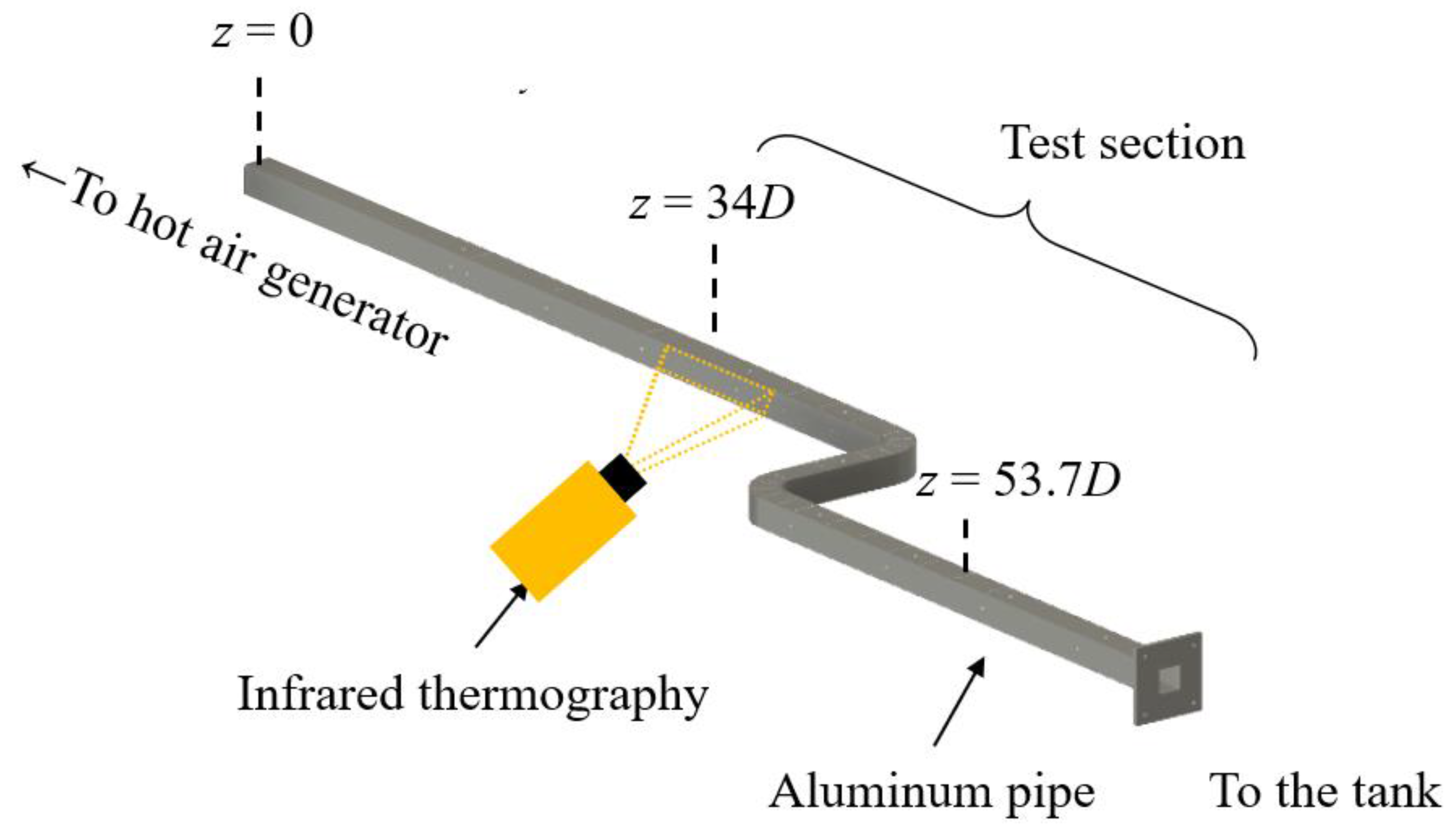
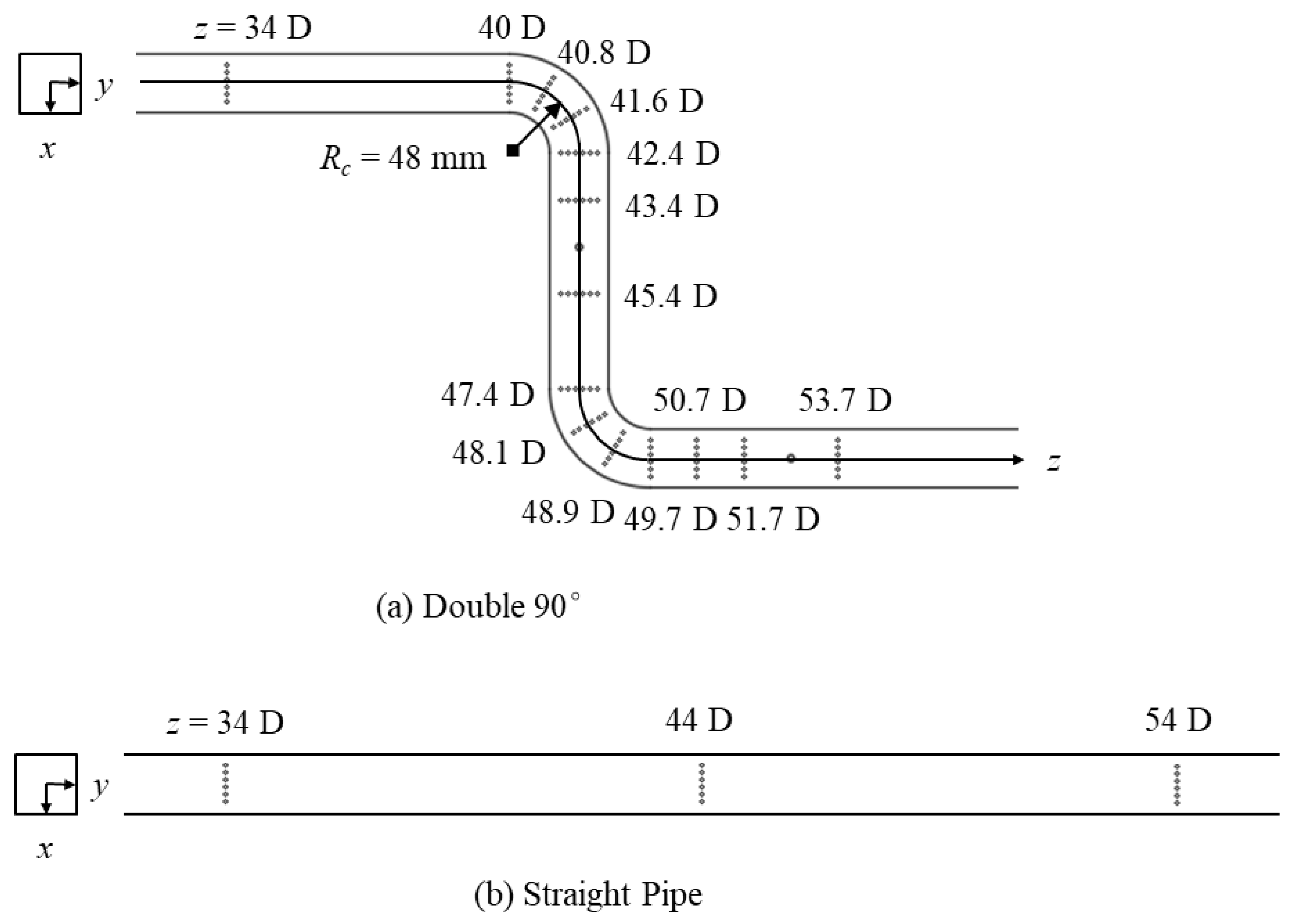
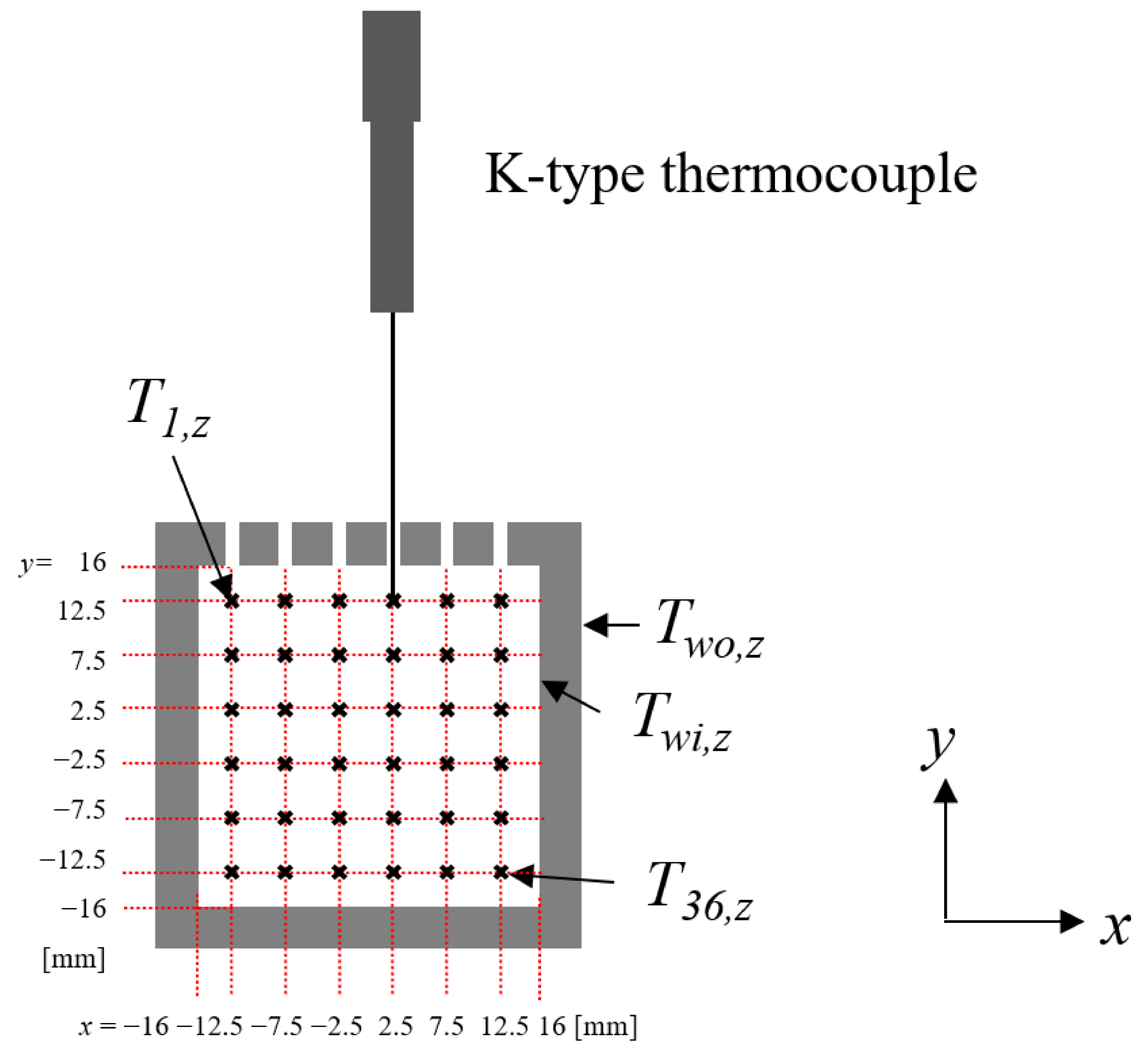
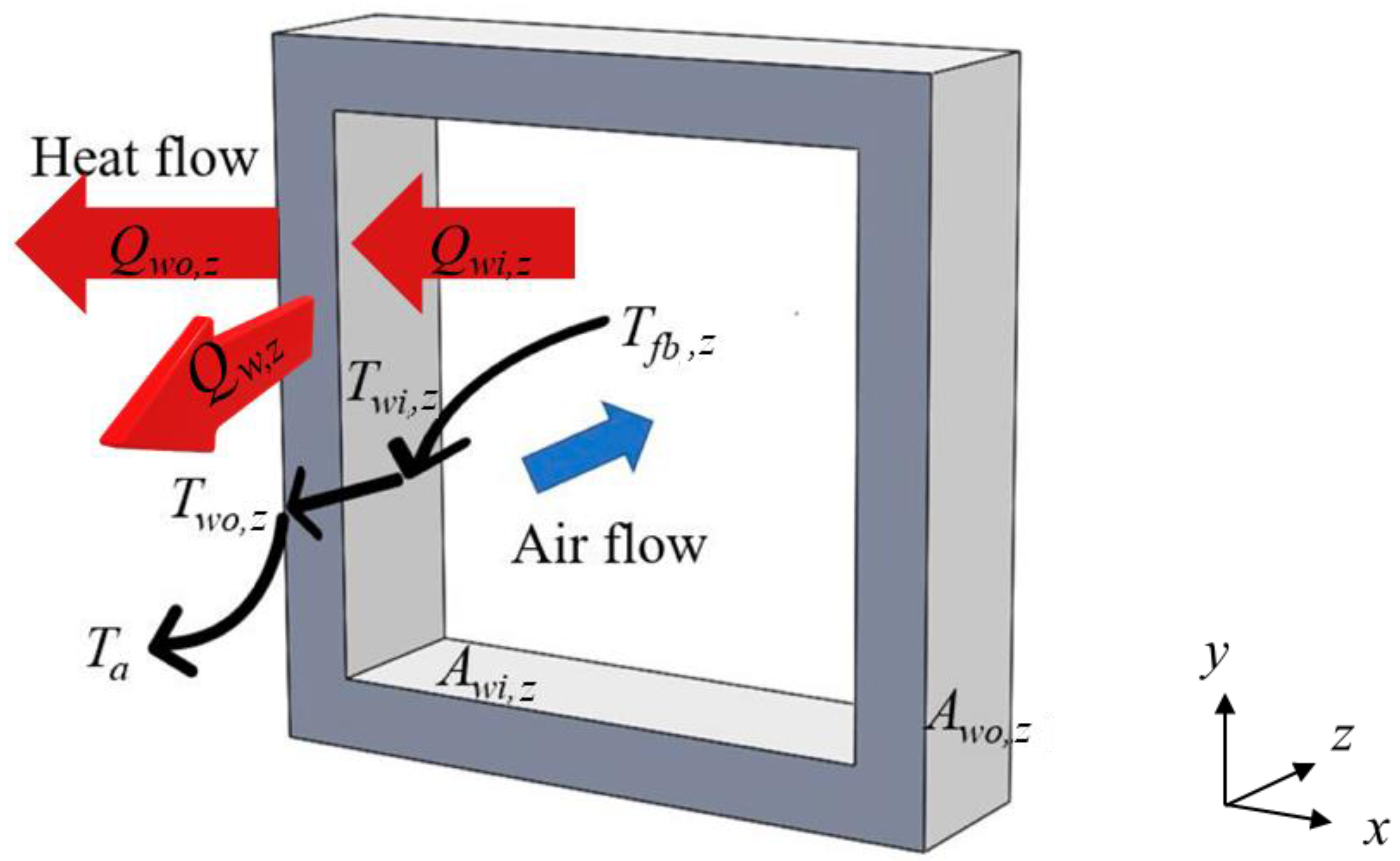


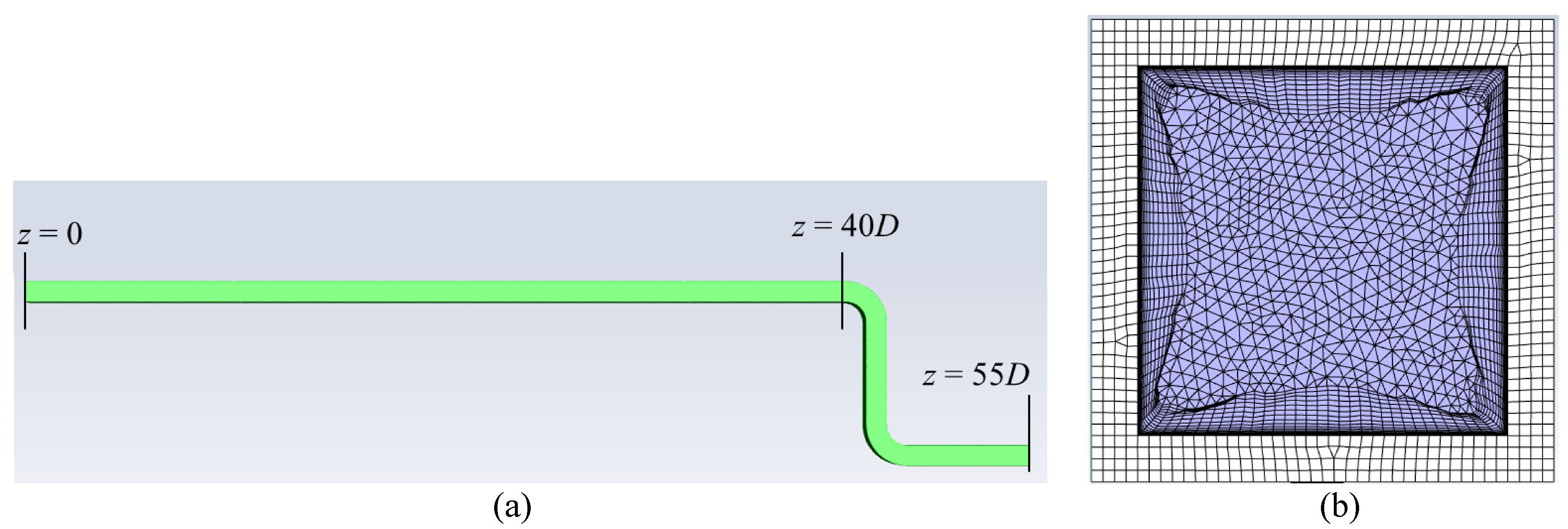
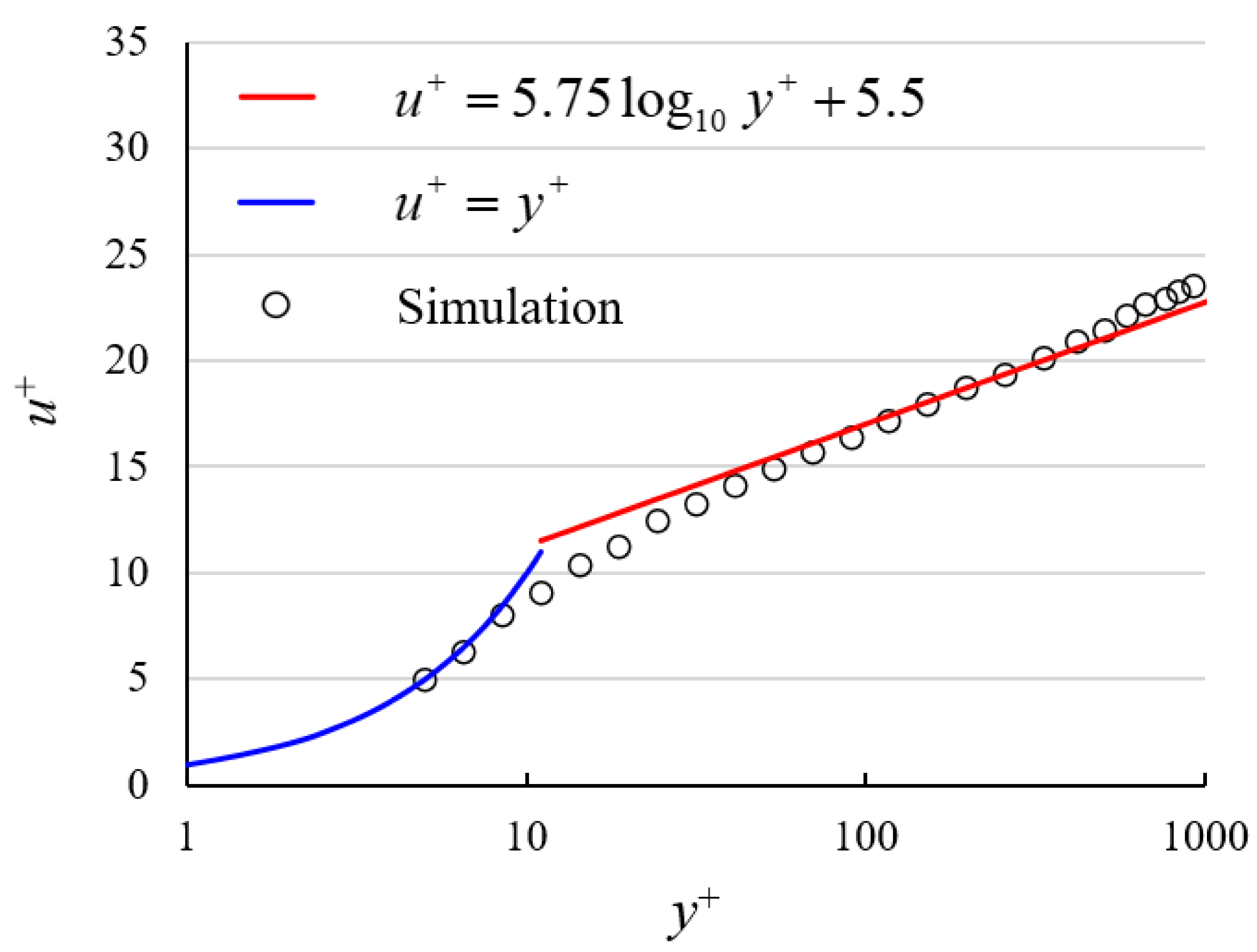
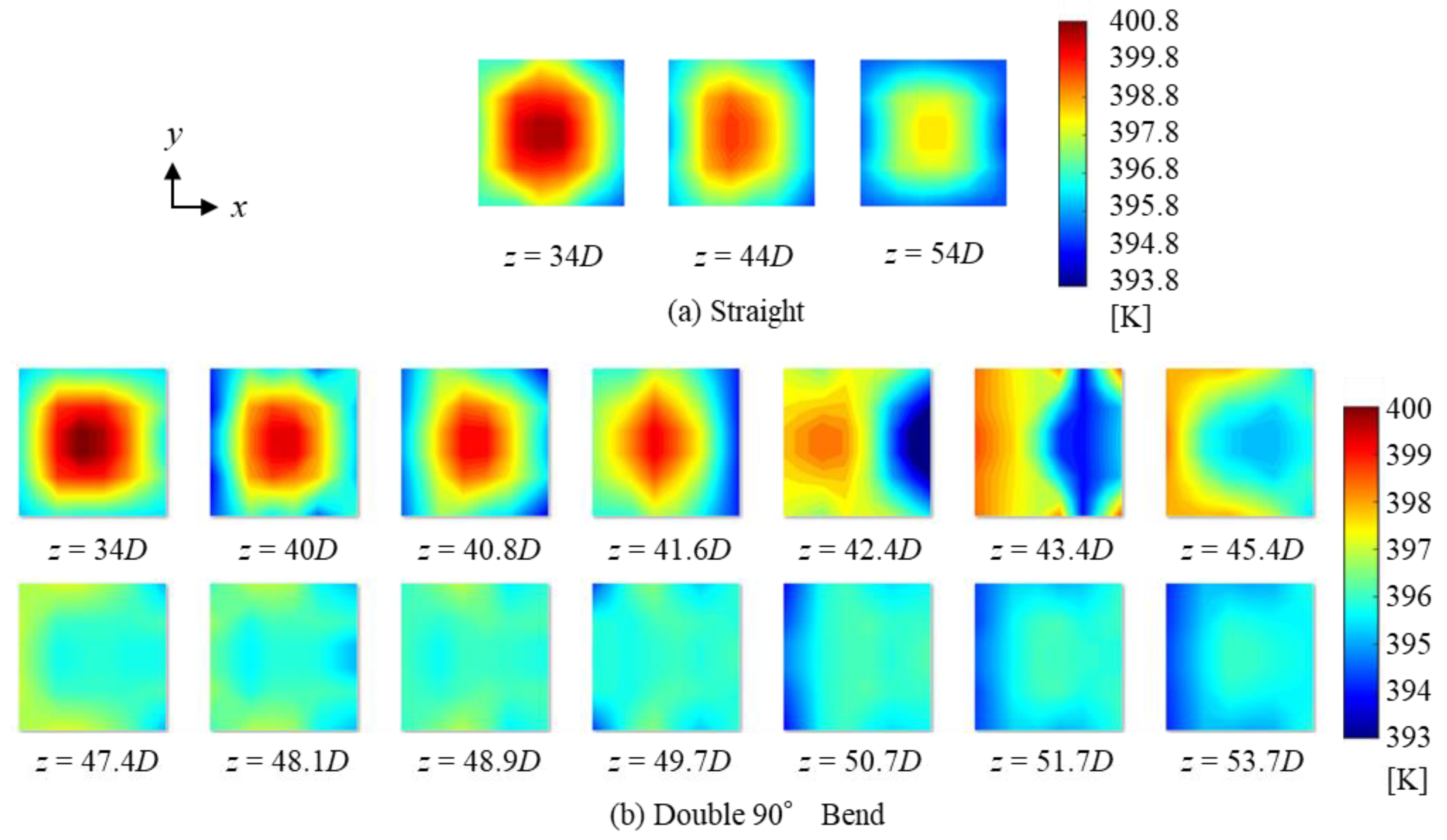
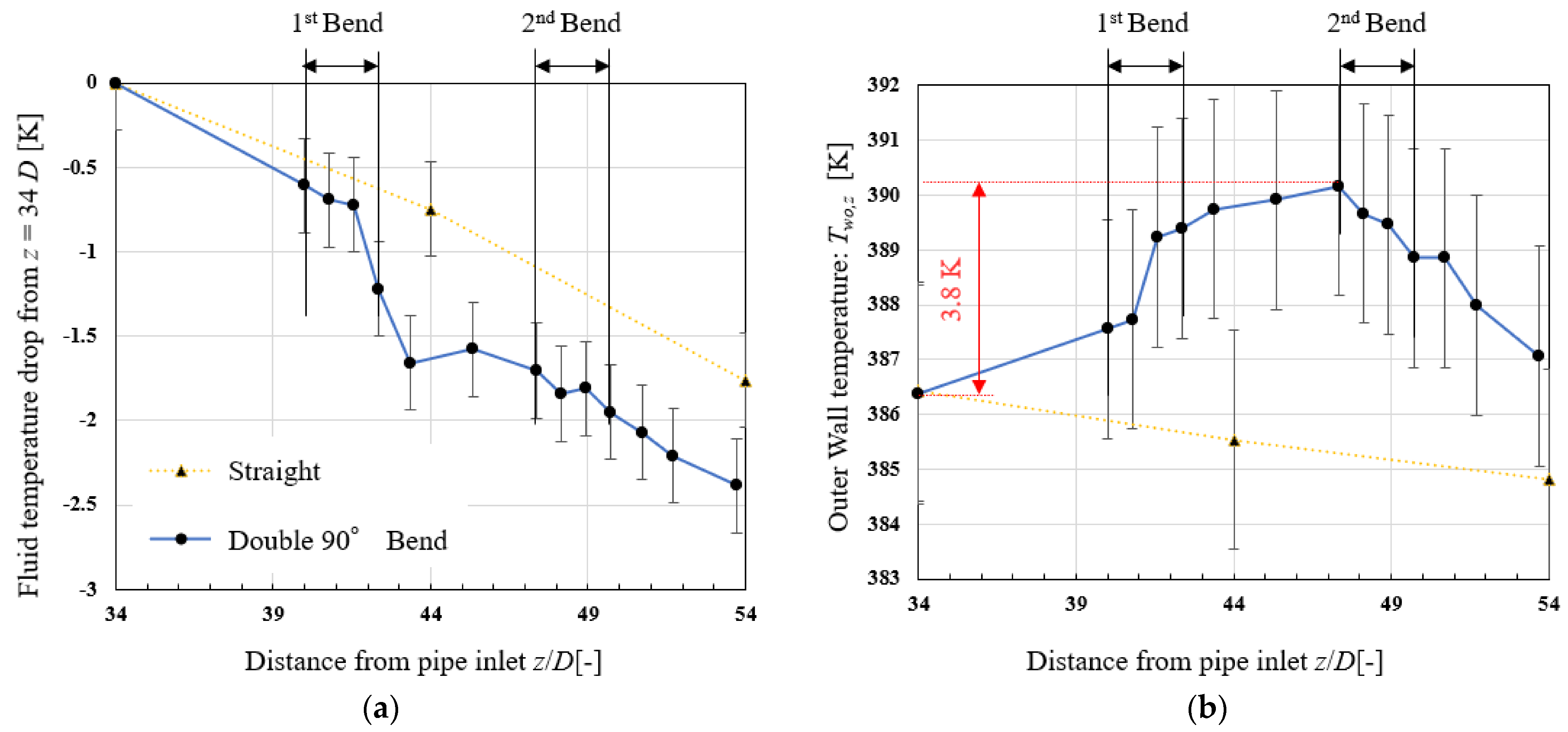
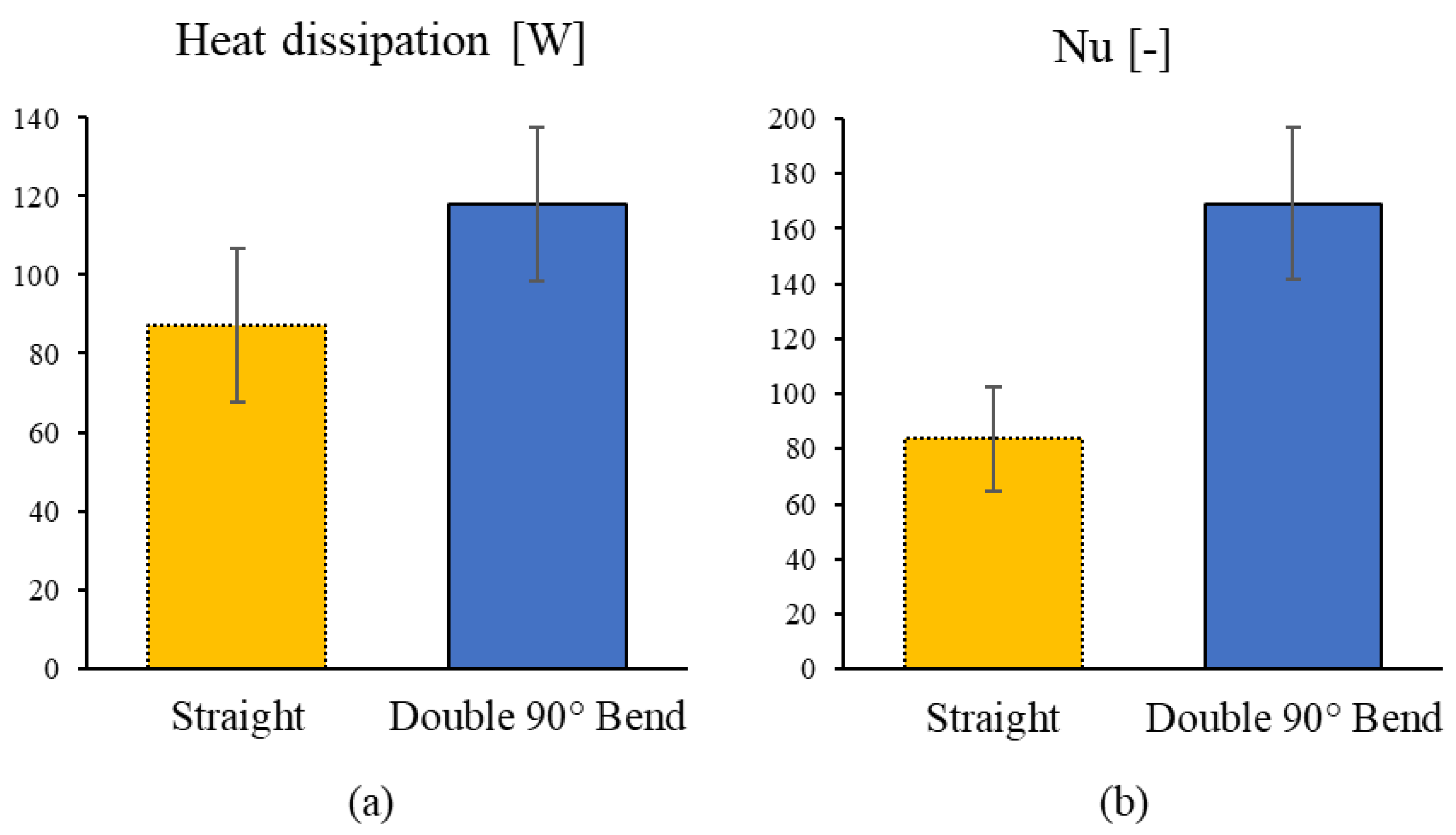


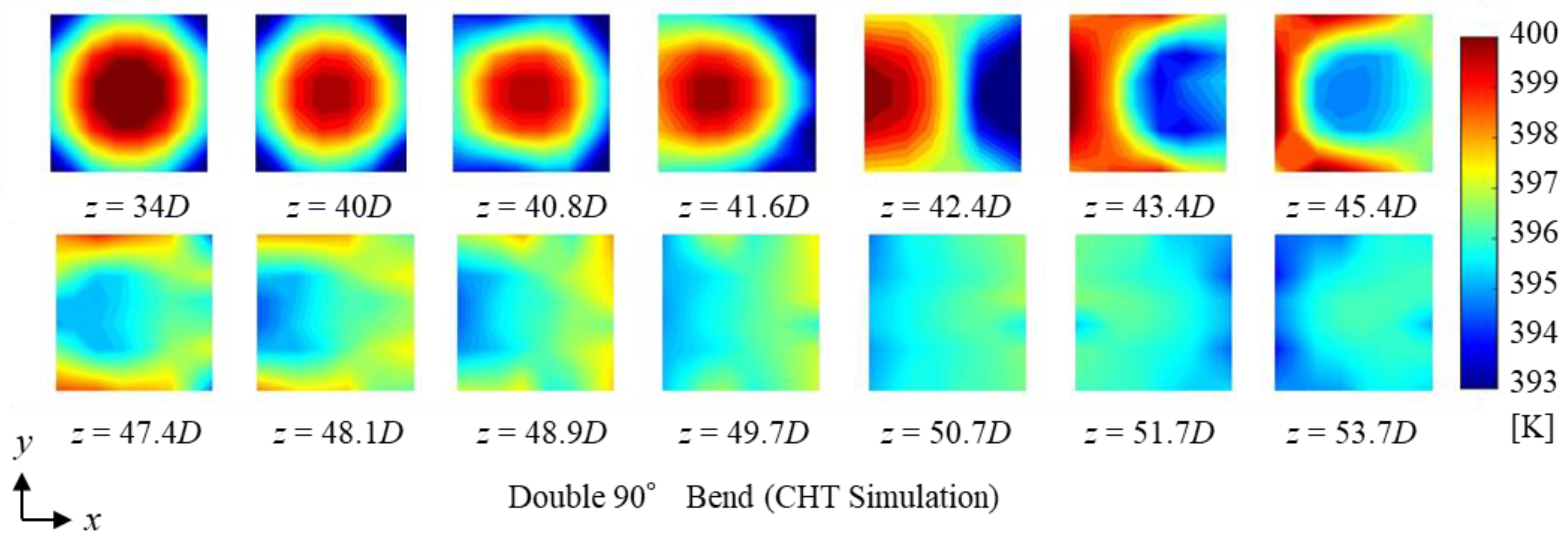
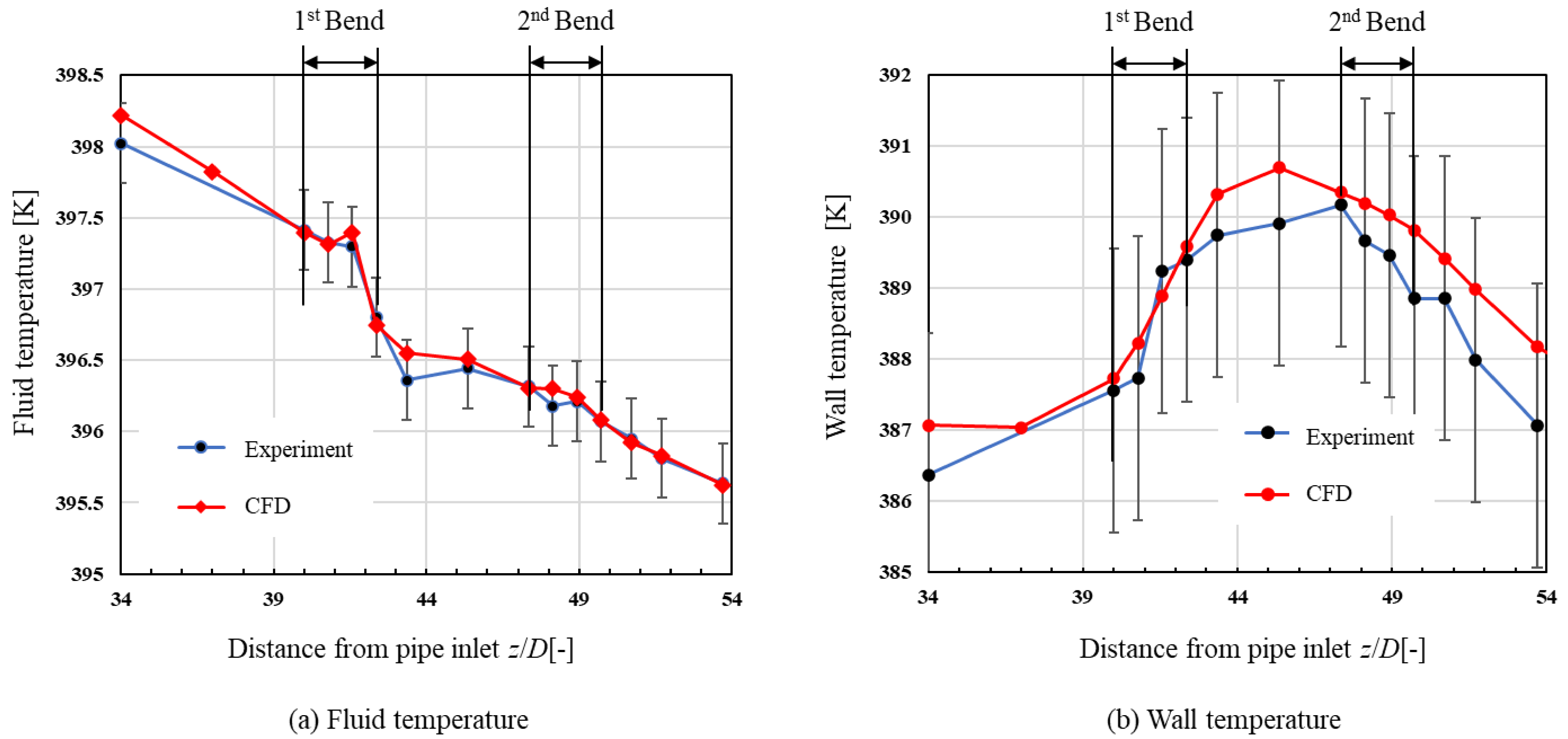



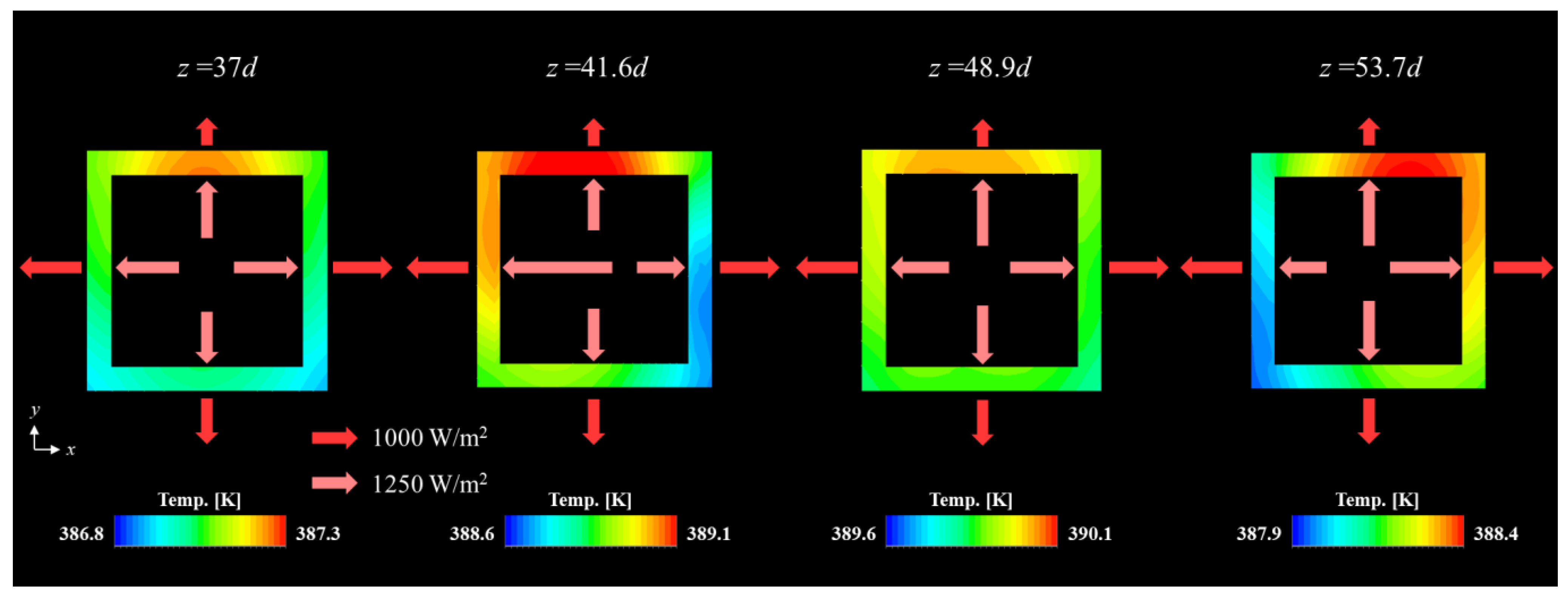
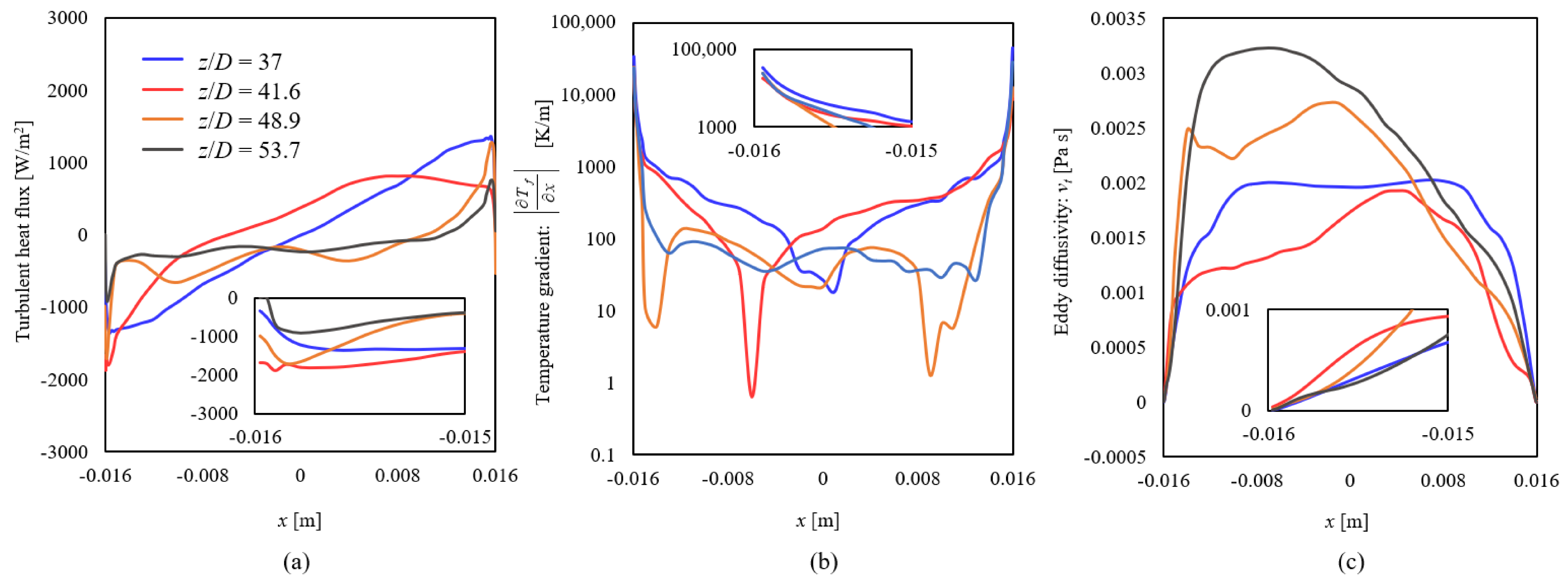
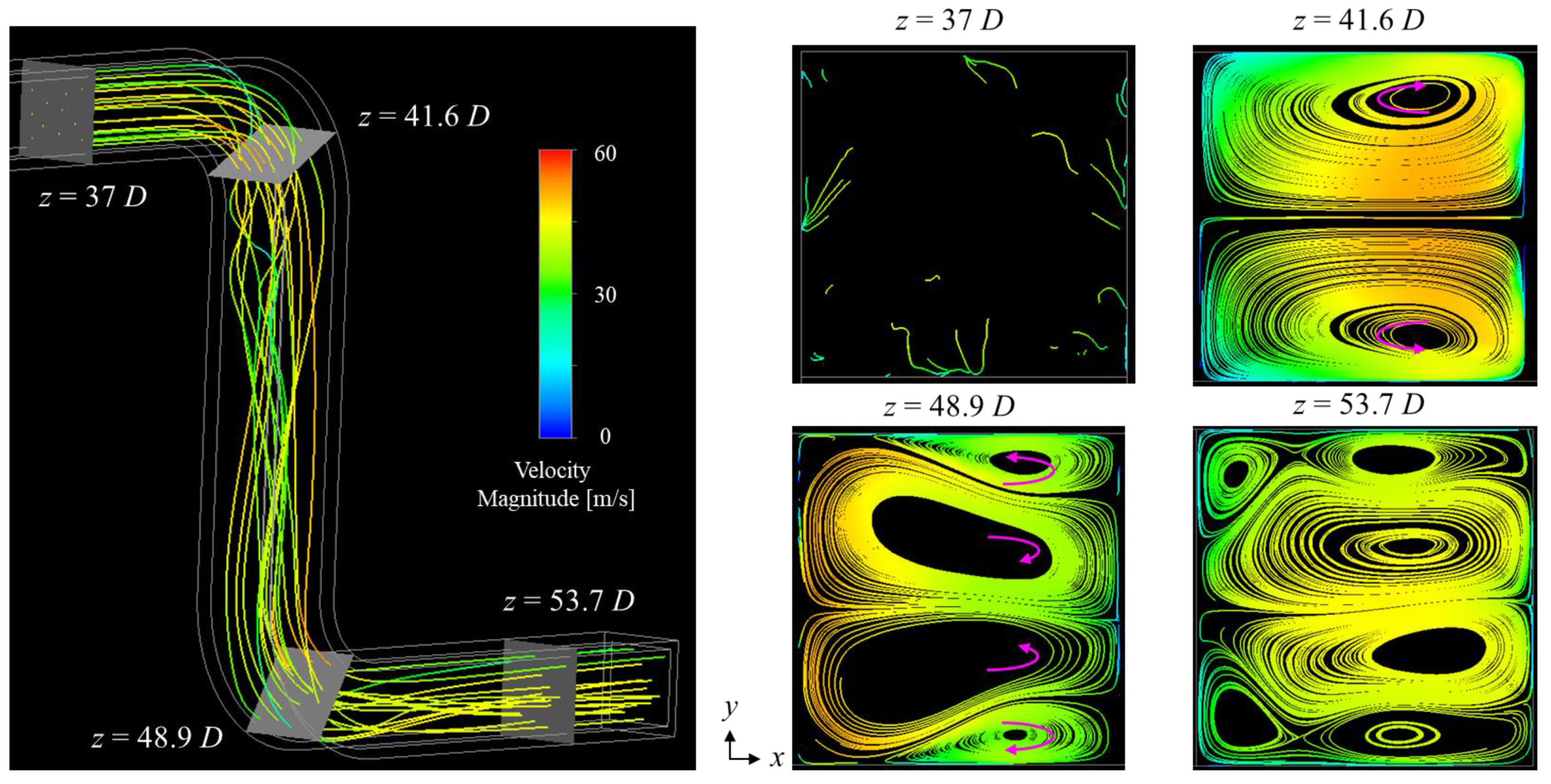
| Viscosity: μ [μPa s] | Density: ρ [kg/m3] | Heat Conductivity of Air: λf [W/m K] | Isobaric Specific Heat: Cp [kJ/kg K] |
|---|---|---|---|
| 23 | 1.03 | 0.033 | 1.01 |
| Frame Speed: fs [fps] | Resolution: rPIV [mm/Pixel]. | Time Interval between Laser Pulses: Δt [μs]. | Grid Size [Pixel]. | Interrogation Window Size [Pixel] |
|---|---|---|---|---|
| 10,000 | 0.1 | 10 | 8 | 27 × 27 |
| Density | Momentum | Turbulent Kinetic Energy | Specific Dissipation Rate | Energy | |
|---|---|---|---|---|---|
| Discretization method | Second order upwind | Second order upwind | First order upwind | First order upwind | Second order upwind |
| Case A | Case B | Case C | Case D | |
|---|---|---|---|---|
| Base mesh size [mm] | 1 | 0.75 | 1 | 2.5 |
| First layer thickness of the mesh [mm] | 0.06 | 0.06 | 0.02 | 0.06 |
Disclaimer/Publisher’s Note: The statements, opinions and data contained in all publications are solely those of the individual author(s) and contributor(s) and not of MDPI and/or the editor(s). MDPI and/or the editor(s) disclaim responsibility for any injury to people or property resulting from any ideas, methods, instructions or products referred to in the content. |
© 2023 by the authors. Licensee MDPI, Basel, Switzerland. This article is an open access article distributed under the terms and conditions of the Creative Commons Attribution (CC BY) license (https://creativecommons.org/licenses/by/4.0/).
Share and Cite
Kato, Y.; Fujimoto, K.; Guo, G.; Kawaguchi, M.; Kamigaki, M.; Koutoku, M.; Hongou, H.; Yanagida, H.; Ogata, Y. Heat Transfer Characteristics of Turbulent Flow in Double-90°-Bend Pipes. Energies 2023, 16, 7314. https://doi.org/10.3390/en16217314
Kato Y, Fujimoto K, Guo G, Kawaguchi M, Kamigaki M, Koutoku M, Hongou H, Yanagida H, Ogata Y. Heat Transfer Characteristics of Turbulent Flow in Double-90°-Bend Pipes. Energies. 2023; 16(21):7314. https://doi.org/10.3390/en16217314
Chicago/Turabian StyleKato, Yuki, Kenmei Fujimoto, Guanming Guo, Mikimasa Kawaguchi, Masaya Kamigaki, Masanobu Koutoku, Hitoshi Hongou, Haruna Yanagida, and Yoichi Ogata. 2023. "Heat Transfer Characteristics of Turbulent Flow in Double-90°-Bend Pipes" Energies 16, no. 21: 7314. https://doi.org/10.3390/en16217314
APA StyleKato, Y., Fujimoto, K., Guo, G., Kawaguchi, M., Kamigaki, M., Koutoku, M., Hongou, H., Yanagida, H., & Ogata, Y. (2023). Heat Transfer Characteristics of Turbulent Flow in Double-90°-Bend Pipes. Energies, 16(21), 7314. https://doi.org/10.3390/en16217314





